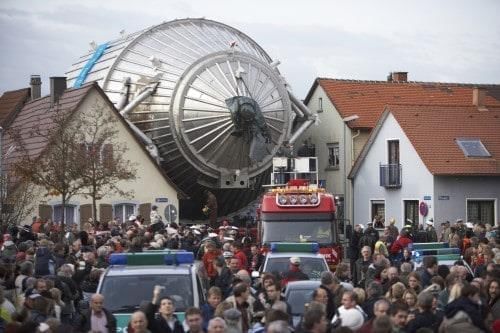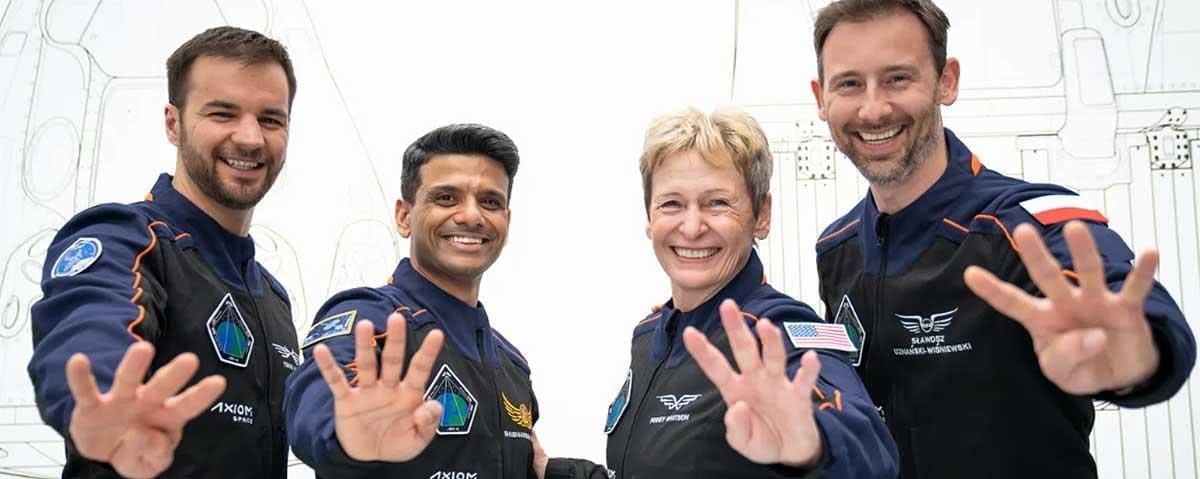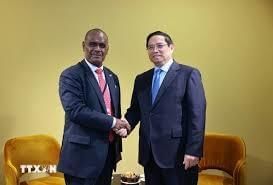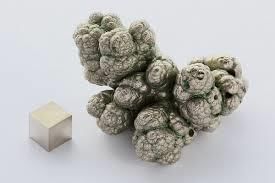UPSC Daily Current Affairs: 11th June 2025 | Current Affairs & Hindu Analysis: Daily, Weekly & Monthly PDF Download
GS3/Science and Technology
KATRIN Experiment Sets Strongest Limit on Neutrino Mass
Source: The Hindu
 Why in News?
Why in News?
The Karlsruhe Tritium Neutrino Experiment (KATRIN) in Germany has made significant progress in the ongoing quest to accurately measure the mass of neutrinos, a fundamental particle in physics.
Key Takeaways
- KATRIN has achieved a breakthrough in determining neutrino mass limits.
- Neutrinos are elusive particles that play a crucial role in understanding the universe.
What are Neutrinos?
- Definition: Neutrinos are tiny, electrically neutral subatomic particles with an extremely small mass.
- Types: They exist in three varieties: electron, muon, and tau neutrinos.
- Production: Neutrinos are generated through nuclear reactions, such as those occurring in the Sun, nuclear reactors, and supernovae.
- Interaction: They rarely interact with matter, making them challenging to detect.
- Oscillation: The phenomenon where neutrinos change from one flavor to another indicates they possess mass.
- Implications: Their properties challenge the Standard Model of physics, suggesting there may be undiscovered particles or forces.
About the KATRIN Experiment
- Objective: The KATRIN experiment, located at the Karlsruhe Institute of Technology, aims to measure the absolute mass of electron antineutrinos with high precision.
- Launch and Operation: It was inaugurated in 2018 and began data collection in 2019, utilizing a total of 259 days of measurements to derive its latest results.
- Scientific Principle: KATRIN employs the process of tritium beta decay, where tritium decays into helium, an electron, and a neutrino, to analyze the energy spectrum of emitted electrons.
- Focus Area: The experiment specifically examines electrons close to the energy endpoint, as they are most influenced by the neutrino mass.
How KATRIN Measures Neutrino Mass
- KATRIN concentrates on electrons emitted with energies near the maximum limit, known as the endpoint, which are significantly affected by neutrino mass.
- A retarding electric field is used to filter out lower-energy electrons, ensuring that only the highest-energy electrons are measured accurately.
- By analyzing millions of decay events, KATRIN estimates the upper limit on the neutrino mass.
India’s Achievements in Neutrino Observations
- Historical Detection: India was among the first nations to identify atmospheric neutrinos in 1965 at the Kolar Gold Fields (KGF), marking a significant milestone in neutrino physics.
- INO Project: The India-Based Neutrino Observatory (INO), under development in Tamil Nadu, is set to become a leading underground research facility.
- Flagship Detector: INO will feature the Iron Calorimeter (ICAL), a 50,000-tonne magnetized detector, which will be the largest of its kind globally.
- Applications: INO aims to advance detector technologies, facilitate training in high-energy physics, and explore potential applications in medical imaging and electronics.
- Global Integration: India's engagement in neutrino science positions it to offer unique insights into worldwide initiatives, complementing projects like IceCube.
Question: The India-based Neutrino Observatory is recognized by the Planning Commission as a mega science project under the 11th Five-Year Plan. Evaluate the following statements:
- 1. Neutrinos are chargeless elementary particles that travel close to the speed of light.
- 2. Neutrinos are created in nuclear reactions of beta decay.
- 3. Neutrinos have a negligible, but nonzero mass.
- 4. Trillions of neutrinos pass through the human body every second.
Which of the statements given above are correct?
- (a) 1 and 3 only
- (b) 1, 2, and 3
- (c) 2, 3, and 4
- (d) 1, 2, 3, and 4 *
This information underscores the advancements in neutrino research and the significant role India plays in this field, enhancing our understanding of fundamental physics.
GS1/Indian Society
India’s Declining Fertility Rate and Its Demographic Implications: UNFPA Report 2025
Source: The Hindu
Why in News?
India’s population is projected to have reached 146.39 crore by April 2025, according to a recent UN demographic report.
Key Takeaways
- India's fertility rate has decreased to 1.9, falling below the replacement level of 2.1.
- The country remains the world's most populous, with projections indicating a peak of 170 crore in the coming decades.
- Financial constraints and changing family dynamics are significant factors influencing fertility decisions.
Additional Details
- Demographic Transition: Since 1960, the average number of children per woman in India has significantly decreased from six to 1.9, aided by better reproductive healthcare and women's empowerment initiatives.
- Financial Constraints: Economic challenges were cited by 38% of respondents as a reason for preferring fewer children, reflecting a global trend where financial limitations impact family planning.
- Social Dynamics: Family preferences and healthcare professional influence were noted, with 19% of respondents indicating their partners preferred fewer children.
- Demographic Dividend: Currently, 68% of India's population is in the working-age group (15-64 years), presenting an opportunity for economic growth, albeit with the need for strategic investments as the elderly population increases.
In summary, India's declining fertility rate signals a significant demographic transition that necessitates a shift in policy focus from mere population control to ensuring reproductive rights and supporting families. With the upcoming 2027 Census, there is an opportunity to adapt health and welfare policies to align with these demographic realities.
GS3/Science and Technology
Axiom Mission 4 (Ax-4)
Source: The Hindu
 Why in News?
Why in News?
The Axiom Mission 4, featuring Indian astronaut Group Captain Shubhanshu Shukla, has recently experienced another postponement, heightening public anticipation regarding its launch.
Key Takeaways
- Axiom Mission 4 is the fourth private astronaut mission to the International Space Station (ISS).
- Collaboration involves Axiom Space, NASA, SpaceX, and ISRO.
- The mission aims to enhance commercial activities in low Earth orbit.
Additional Details
- Objectives:
- Facilitate commercial ventures such as space tourism and private research.
- Showcase the viability of commercial space stations for business and scientific purposes.
- Foster international collaboration in space exploration.
- Conduct scientific experiments in microgravity, focusing on materials science, biology, Earth observation, and life sciences.
- Launch Vehicle & Capsule: The mission will utilize the Crew Dragon C213, the fifth and final new Dragon capsule, launched from LC 39A at Kennedy Space Centre atop a Falcon 9 Block 5 rocket.
- Mission Timeline: Initially scheduled for early June 2025, the mission has faced several delays, with the latest postponement occurring on June 11 due to a liquid oxygen leak.
- Crew Members:
- Peggy Whitson (USA)
- Shubhanshu Shukla (India)
- Sławosz Uznański-Wiśniewski (Poland)
- Tibor Kapu (Hungary)
- Significance:
- This mission marks India’s return to human spaceflight after 41 years, following Rakesh Sharma’s mission in 1984.
- It represents the first government-sponsored flights to the ISS for India, Poland, and Hungary in over four decades.
The Axiom Mission 4 is poised to be a landmark event in international space exploration, emphasizing the growing role of private entities in space missions and the collaborative efforts of various nations in advancing scientific research.
GS2/International Relations
Erdogan’s Neo-Ottoman Foreign Policy
Source: The Hindu
Why in News?
Under President Recep Tayyip Erdogan, Türkiye has shifted its foreign policy from a secular stance to one influenced by Islamic values, aiming to establish itself as a formidable regional power. This transformation reflects Türkiye's aspirations to reclaim its historical influence and redefine its role in the contemporary global order.
Key Takeaways
- Türkiye's foreign policy has transitioned from secularism to an Islamist-oriented approach.
- Strategic activism in conflict zones like Syria and Libya has been a hallmark of this new policy.
- Despite its Islamist tilt, Türkiye maintains its position as a key NATO member.
- Erdogan's blend of ideology and pragmatism is aimed at enhancing Türkiye's regional and global leverage.
Additional Details
- Islamist-leaning tilt: Türkiye's shift towards an Islamist approach draws inspiration from Ottoman-era ideologies, such as Ittihad-i Islam (Unity of Islam).
- Strategic activism: Ankara's interventions in conflict zones, such as Syria and Libya, are designed to expand its influence and support Islamist factions.
- Balanced diplomacy: Türkiye continues to engage with Western alliances while pursuing its ideological agenda, demonstrating diplomatic flexibility.
- Pragmatism with ideology: Erdogan's approach combines ideological goals with practical diplomacy to gain strategic advantages.
Türkiye's involvement in regional conflicts has not only aimed at expanding its influence but has also raised ethical concerns, particularly regarding its support for militant groups and the resulting civilian impacts. This policy shift is critical for understanding Türkiye's evolving role on the global stage and its implications for countries like India, which must navigate the challenges posed by Türkiye's new alliances and regional assertiveness.
GS3/Economy
Towards Viksit Bharat - A Decade of Inclusive Growth, Infrastructure, and Empowerment
Source: TOI
Why in News?
This report highlights India’s transformative journey over the past decade, emphasizing the importance of inclusive growth, infrastructure development, digital empowerment, and governance reforms. The focus has shifted from mere economic growth to fostering dignity, opportunity, and a belief in a brighter future for all citizens.
Key Takeaways
- Progress is now measured by dignity, opportunity, and inclusion rather than just GDP.
- Welfare schemes and structural changes have significantly uplifted millions.
A New Bharat in the Making
- Example - Annam Lakshmi Bhavani: From Kadapa, Andhra Pradesh, secured a Mudra loan to start a jute bag manufacturing unit.
- Example - Jagdev Singh: From Haryana, uses an AI app for crop management decisions.
- Example - Meera Manjhi: Received an LPG connection under Ujjwala, ensuring a smokeless kitchen.
Foundational Philosophy
- Antyodaya: Uplifting the last person in the queue.
- Four pillars:
- Building infrastructure that connects.
- Growth that is inclusive.
- Manufacturing that creates jobs.
- Simplifying systems that empower.
Infrastructure Boom - Physical, Digital, and Social
- Capital investment surge: Capex increased to ₹11.2 lakh crore in 2025-26.
- Transport infrastructure: 59,000 km of highways and 37,500 km of railway tracks built in the last 11 years.
- Digital Public Infrastructure (DPI):
- UPI, Aadhaar, and DigiLocker have become global benchmarks.
- Over 141 crore Aadhaar registrations and 60 crore UPI transactions daily.
- IndiaAI Mission: Over 34,000 high-speed computer chips available at one-third of global costs.
Social Inclusion and Basic Services Expansion
- Healthcare and education: Number of medical colleges increased from 387 to 780, and AIIMS institutions from 7 to 23.
- Welfare delivery at scale:
- 530 million Jan Dhan accounts.
- 40 million homes built under PMAY.
- 120 million toilets constructed under SBM.
- 140 million households connected via Har Ghar Jal.
- 350 million covered under Ayushman Bharat.
- 110 million farmers receive direct support via PM-KISAN.
- 100 million families use LPG under Ujjwala Yojana.
Manufacturing and Industrial Growth
- Make in India: Launched in 2015 to create jobs and revive industrial growth.
- Electronics manufacturing: Increased six times to cross ₹12 lakh crore, with exports increasing eight times to ₹3 lakh crore.
- Semiconductor Mission:
- First commercial lab under construction and five OSAT units underway.
- Over 20 chipsets designed by Indian students and engineers.
- 270 universities onboarded for chip design training.
Governance Reforms and Simplification
- A silent revolution: Over 1,500 old laws repealed and more than 40,000 compliances removed.
- New-age laws: Built on trust and simplicity, treating citizens with dignity.
Security and Strategic Clarity
- Shift in approach: From reactive to proactive counter-terror operations.
- New doctrine: Decisive retaliation on India's terms, with zero tolerance for nuclear blackmail.
Economic Trajectory
- 2004: India was the 11th largest economy; status unchanged until 2014.
- Post-2014: Regained momentum and is now the 5th largest economy, poised to become the 3rd largest.
In conclusion, the past decade under the current government has instilled dignity, empowerment, and belief in the citizens of India. Viksit Bharat is not merely a dream; it is a destination being actively built with inclusion and resolve.
GS2/International Relations
Blue Nationally Determined Contributions Challenge
Source: DTE
Why in News?
The Blue NDC Challenge initiative was recently launched on the first day of the third UN Ocean Conference (UNOC3) to significantly enhance climate action focused on ocean preservation.
Key Takeaways
- The initiative is a groundbreaking international effort spearheaded by France and Brazil.
- It calls on nations to integrate ocean-related climate strategies into their Nationally Determined Contributions (NDCs) before the 30th Conference of Parties (COP30) of the UNFCCC in Belem, Brazil.
- Seven countries, including Australia, Fiji, Kenya, Mexico, Palau, and the Republic of Seychelles, have joined this initiative.
Additional Details
- Nationally Determined Contributions (NDCs): These are national climate plans that outline the efforts of countries to lower emissions and adapt to climate change, as stipulated in the Paris Agreement, which was adopted by 195 Parties at UNFCCC COP21 in Paris, France, on December 12, 2015.
- The ultimate goal of the NDCs is to maintain the increase in global average temperature to well below 2°C above pre-industrial levels and to pursue efforts to limit the temperature rise to 1.5°C.
- The initiative is supported by various organizations, including Ocean Conservancy, the Ocean and Climate Platform, and the World Resources Institute through the Ocean Resilience and Climate Alliance (ORCA), and has also received endorsement from WWF-Brazil.
This initiative emphasizes the crucial role of oceans in climate action and encourages countries to take significant steps towards incorporating ocean-centric strategies in their climate commitments.
GS3/Science and Technology
Magnetic Isolation and Concentration Cryo-electron Microscopy (MagIC)
Source: The Hindu
Why in News?
Researchers from Rockefeller University have introduced a revolutionary method that enhances cryo-electron microscopy (cryo-EM) by allowing it to work with samples that are up to 100 times more dilute. This advancement facilitates the study of rare or hard-to-purify molecules.
Key Takeaways
- Cryo-EM is a powerful technique for visualizing the 3D shapes of small biological entities, including proteins, viruses, and cellular components.
- Traditional cryo-EM requires concentrated samples, which can be challenging for rare molecules.
- MagIC utilizes magnetic isolation and concentration to enhance the performance of cryo-EM, making it viable for less abundant samples.
Additional Details
- Cryo-Electron Microscopy (Cryo-EM): This technique involves rapidly freezing samples to preserve their natural shape and using an electron beam to capture high-resolution images at extremely low temperatures.
- Challenge Addressed: Conventional cryo-EM requires high concentrations of molecules to obtain clear images, posing difficulties when samples are too dilute.
- MagIC Method: Developed in the U.S., this method incorporates tiny magnetic beads (50 nanometers in size) that bind to target molecules. A magnet then clusters these beads, enabling scientists to visualize even very low concentrations (below 0.0005 milligrams per milliliter).
- Key Features of MagIC:
- Magnetic Pulling: Facilitates the clustering of molecules, enhancing visibility.
- Low Sample Requirement: Requires only 5 nanograms of sample per grid, significantly less than previous methods.
- Faster Imaging: The visibility of magnetic beads allows for quicker identification of useful areas in the sample.
- Smart Software – DuSTER: This software filters out poor quality images, retaining only clear ones by checking location consistency.
In summary, MagIC significantly improves the accessibility and effectiveness of cryo-EM for studying rare biological molecules, paving the way for new discoveries in molecular biology and medicine.
GS2/International Relations
The Hazards of Going Global on India-Pakistan Issues
Source: The Hindu
Why in News?
The ongoing conflict between India and Pakistan, especially regarding Jammu and Kashmir (J&K), has resurfaced after Operation Sindoor. This situation highlights the persistent hostility between the two nations and exposes the limitations of both bilateral and multilateral diplomatic efforts in resolving such deep-rooted disputes.
Key Takeaways
- The India-Pakistan conflict is influenced by historical, geopolitical, and ideological factors.
- Traditional diplomatic methods have largely failed to resolve the issues surrounding J&K.
- The lack of a universally accepted definition of terrorism complicates India's international stance.
- The UN's role and the problem of hyphenation between India and Pakistan hinder effective diplomacy.
- India is focusing on strategic autonomy to address bilateral relations moving forward.
Additional Details
- Historical Context: The India-Pakistan conflict has its roots in the geopolitical dynamics post-World War II and during the Cold War, which shaped rigid ideological stances that limit diplomatic flexibility.
- UN Representation: UN maps and documents often obscure the realities of J&K, preventing clear international recognition of India's sovereignty.
- Terrorism as a Central Issue: India's attempts to address terrorism in its international relations have faced resistance, especially with the absence of a clear global definition of terrorism.
- UN Security Council's Role: While the UNSC has passed resolutions on terrorism, the lack of clarity and enforcement has rendered them ineffective.
- Strategic Autonomy: India aims to pursue a strategy focused on counter-terrorism and the status of Pakistan-Occupied Kashmir, acknowledging that international mediation is impractical.
The ongoing situation between India and Pakistan, particularly concerning Kashmir, exemplifies the limitations of diplomatic efforts when historical, ideological, and geopolitical interests converge. The role of international institutions like the UN often reflects power politics rather than neutrality, compelling India to prioritize its sovereignty through pragmatic self-reliance rather than relying on an ineffective international system.
GS3/Environment
Kerala Seeks Wildlife Act Amendment to Cull Problematic Wild Animals
Source: Deccan Herald
Why in News?
Kerala has approached the central government with a request to amend the Wildlife (Protection) Act, 1972, aiming to gain permission to cull wild animals that invade human settlements and pose threats to lives and property.
Key Takeaways
- Kerala identifies 273 conflict hotspots due to rising wildlife attacks.
- Key problematic species include tigers, leopards, and wild boars.
- Human casualties from wildlife attacks have reached 919 deaths and 8,967 injuries since 2016.
- Habitat degradation and human activities are exacerbating human-wildlife conflicts.
- The state government seeks controlled culling measures to manage wildlife populations effectively.
Additional Details
- Problematic Species: The main animals involved are tigers, leopards, elephants, bison, wild boars, bonnet macaques, and peafowls. While bonnet macaques and peafowls are not directly dangerous, their crop raiding has led to significant agricultural losses.
- Human Casualties: The period from 2016-2017 to January 2025 has seen alarming wildlife attacks, resulting in 919 fatalities and nearly 9,000 injuries, highlighting the urgency for legislative changes.
- Habitat Degradation: The decline in forest habitat quality forces wildlife to encroach on human settlements in search of food and space.
- Legal Hurdles: Existing laws necessitate exhausting all options like capture and relocation before considering the killing of Schedule I protected animals, delaying emergency responses.
- Need for Culling: The Kerala government advocates for a limited and regulated culling process, confined by region, season, and threat level, to safeguard lives and agricultural interests.
- Classification as Vermin: Kerala seeks to classify wild boars as vermin under Section 62 of the Wildlife Protection Act, allowing for controlled culling for a specified duration.
- Revisiting Protection Status: The government aims to remove the bonnet macaque from Schedule I to facilitate quicker intervention in human-wildlife conflicts.
In conclusion, Kerala's appeal for amendments to the Wildlife Act reflects the pressing need to address the escalating human-wildlife conflicts while ensuring the safety of local communities and agricultural productivity.
GS2/International Relations
Third United Nations Ocean Conference (UNOC3)
Source: Outlook Business
 Why in News?
Why in News?At the Third United Nations Ocean Conference (UNOC3) held in Nice, co-hosted by France and Costa Rica, India emphasized the urgent need for international cooperation to safeguard the world's oceans.
Key Takeaways
- The UNOC aims to support Sustainable Development Goal 14 (SDG 14) which focuses on life below water.
- Issues addressed include marine pollution, overfishing, climate change, and habitat degradation.
- India showcased significant initiatives to protect ocean health and promote sustainable practices.
Additional Details
- About United Nations Ocean Conference (UNOC): This forum brings together various stakeholders including governments, NGOs, academia, and private sectors to collaborate on ocean-related challenges.
- Timeline of Conferences:
- 2017: First conference in New York, co-hosted by Fiji and Sweden.
- 2022: Second conference held in Lisbon, Portugal, and Kenya.
- 2025: Third conference to be hosted.
- 2028: Fourth conference expected to be hosted by Chile and South Korea (yet to be announced officially).
- Financial and Policy Impact: Since 2014, UNOC has mobilized over $130 billion and has resulted in over 2,160 voluntary commitments for ocean protection.
- Major Indian Initiatives Showcased at UNOC3 (2025):
- Deep Ocean Mission: Progress on the 'Samudrayaan' mission, targeting a depth of 6,000 meters.
- Plastic Pollution Action: Emphasis on the national ban on single-use plastics and the 'Swachh Sagar, Surakshit Sagar' campaign, which has cleaned over 1,000 kilometers of coastline.
- Blue Economy Development: Under the Sagarmala Programme, $80 billion has been invested in port-led infrastructure.
- Marine Biodiversity Efforts: Expanded Marine Protected Areas covering 6.6% of India's Exclusive Economic Zone.
- Marine Data Transparency: Launched the SAHAV Portal for digital ocean governance.
The United Nations Convention on the Law of the Sea (UNCLOS) serves as the legal framework for these discussions. It regulates maritime activities and defines various maritime zones, ensuring that coastal states can establish territorial limits and protect maritime resources.
GS3/Science and Technology
Key Facts about Nickel
Source: Live Science
 Why in News?
Why in News?A recent study has highlighted a more sustainable method for nickel extraction from low-grade ores using hydrogen plasma instead of traditional carbon methods.
Key Takeaways
- Nickel is a metallic element characterized by a silvery-white, shiny appearance.
- It ranks as the fifth-most abundant element in the Earth's crust and core.
- Nickel is commonly found in meteorites, in addition to being naturally present in soil and water.
- This element is essential for plant nutrition and is crucial in various products due to its remarkable physical and chemical properties.
Additional Details
- Nickel Sources: Nickel primarily occurs in the form of oxides, sulphides, and silicates. India has significant reserves of nickel laterite, especially located in the Sukinda region of Odisha.
- Global Distribution: Major nickel reserves are found in countries such as Indonesia (22%), Australia (21%), Brazil (17%), Russia (7%), Cuba (6%), and the Philippines (5%).
- Applications: Nickel is predominantly used in alloying, particularly with chromium and other metals, to create stainless and heat-resistant steels. It plays a vital role in clean energy technologies, including Electric Vehicles (EVs), and is utilized in various batteries, such as rechargeable nickel-cadmium and nickel-metal hydride batteries used in hybrid vehicles.
This information underscores the importance of nickel not only in industrial applications but also in advancing sustainable practices in its extraction and use.
|
43 videos|5366 docs|1135 tests
|
FAQs on UPSC Daily Current Affairs: 11th June 2025 - Current Affairs & Hindu Analysis: Daily, Weekly & Monthly
| $1. What is the significance of the KATRIN experiment in neutrino research? |  |
| $2. How does India's declining fertility rate impact its demographic structure? |  |
| $3. What are the key objectives of the Axiom Mission 4 (Ax-4)? |  |
| $4. How does Erdogan's neo-Ottoman foreign policy influence Turkey's international relations? |  |
| $5. What are the potential benefits of amending wildlife acts in Kerala to manage problematic wild animal populations? |  |
















